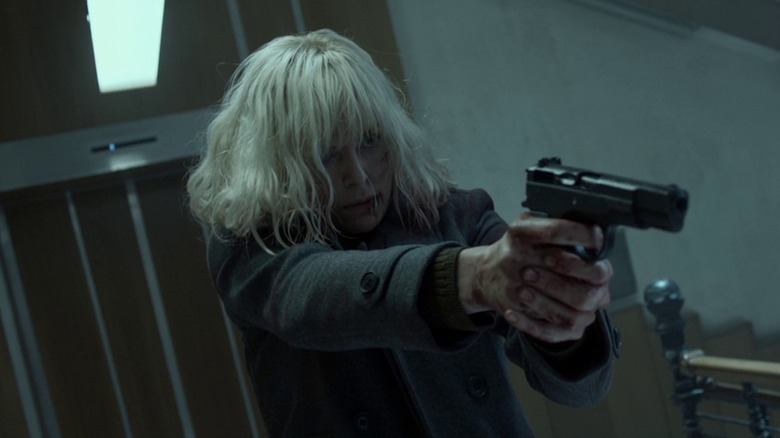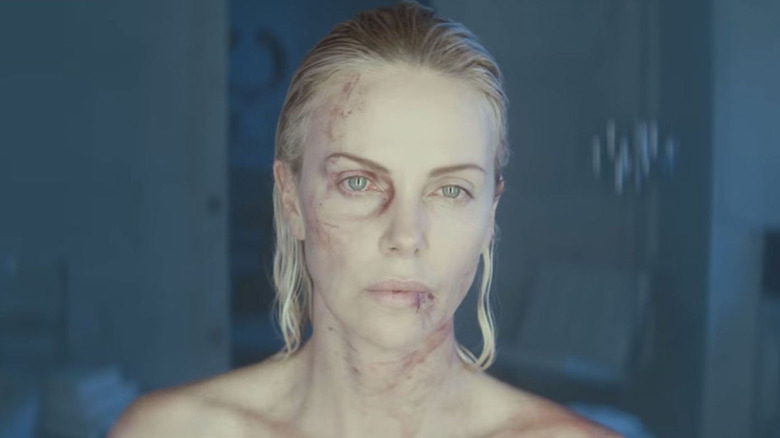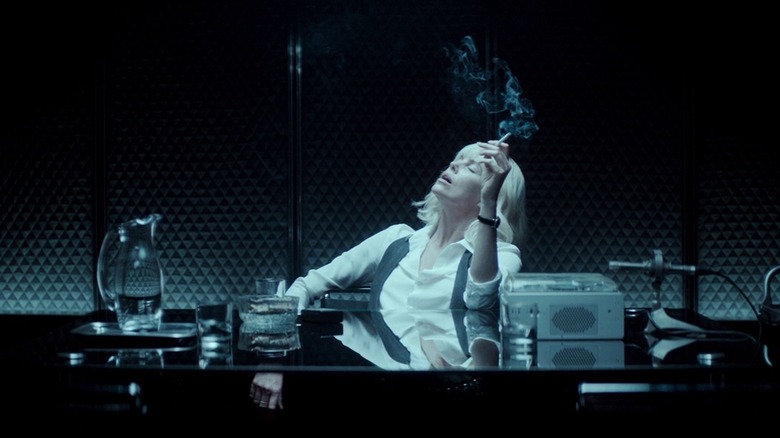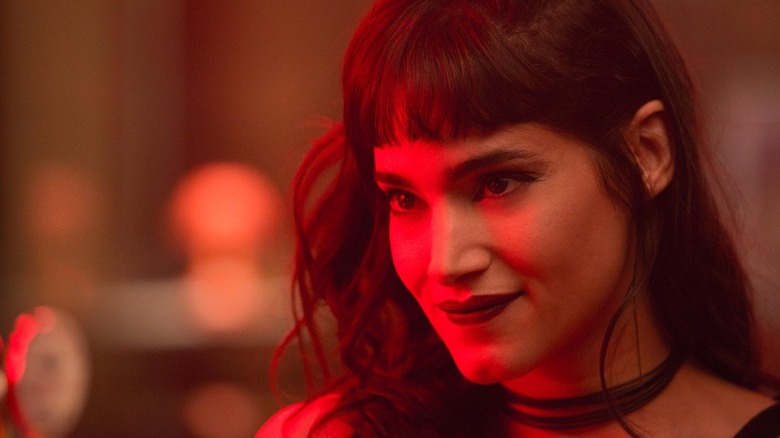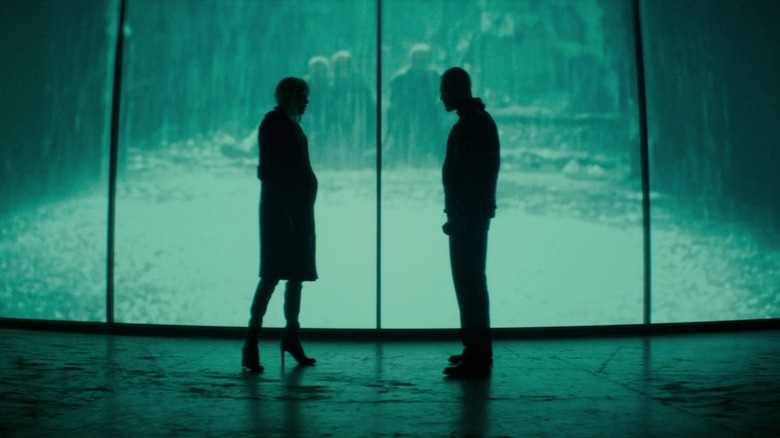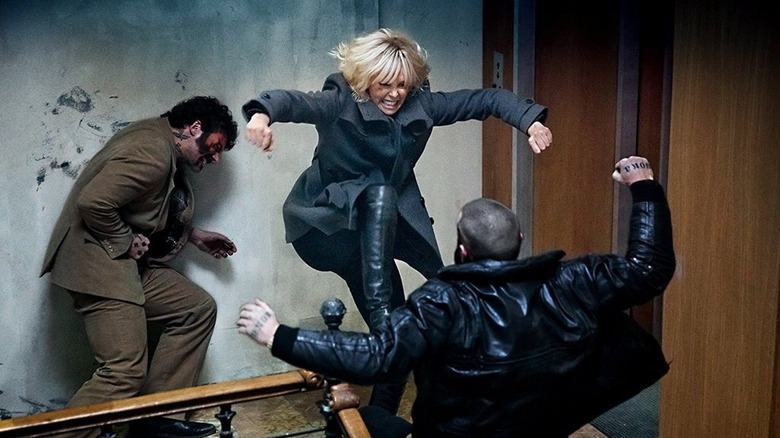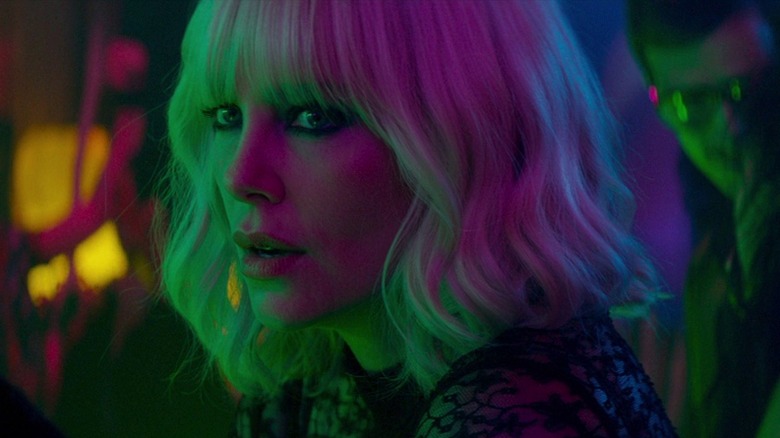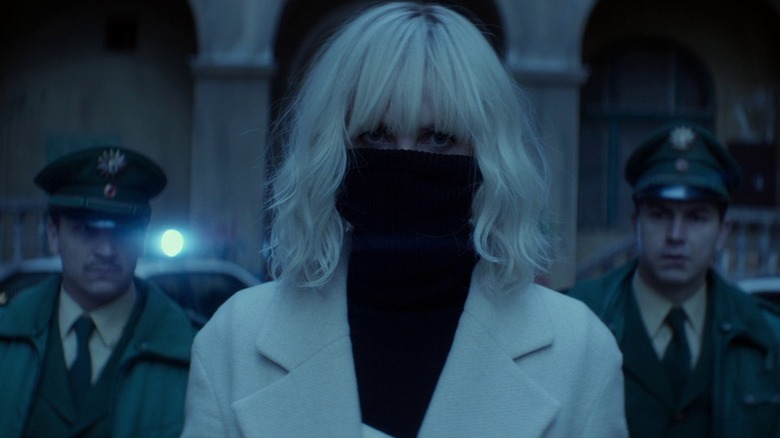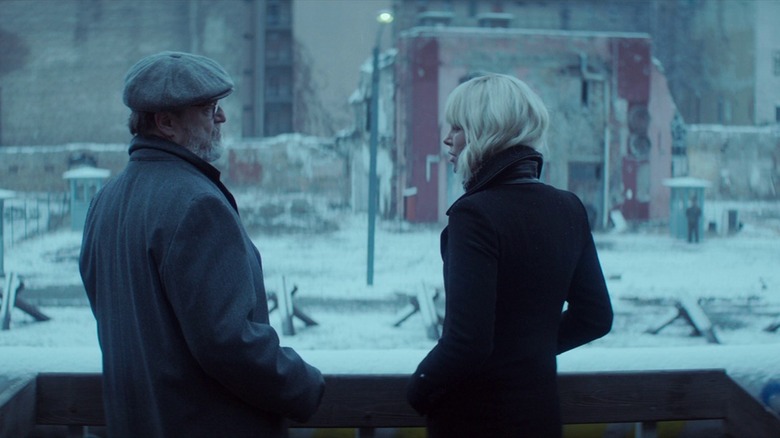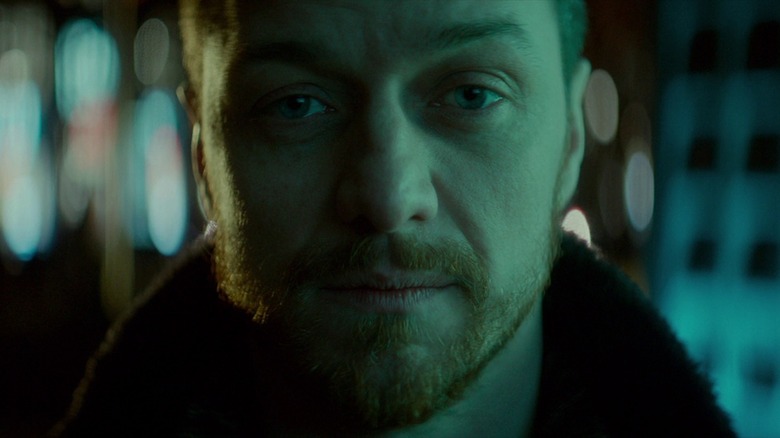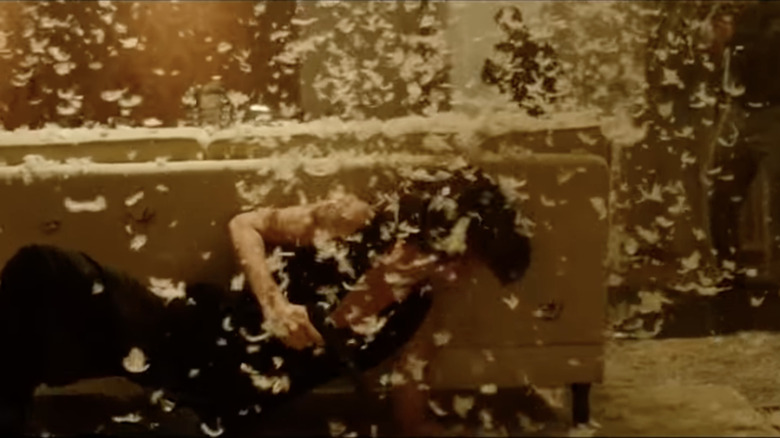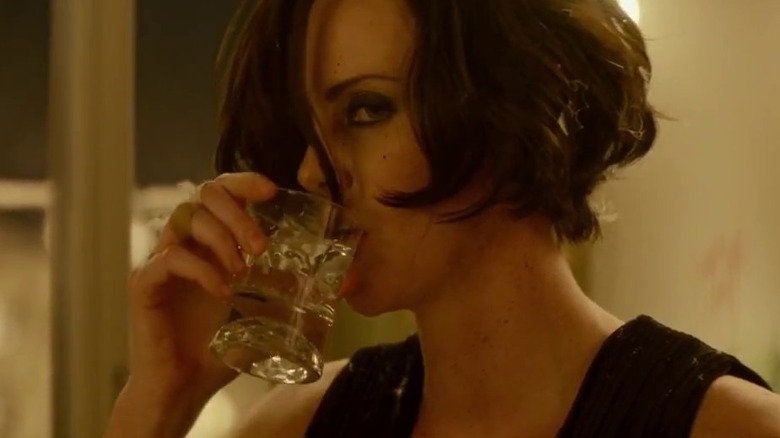Things You Only Notice In Atomic Blonde After Watching It Again
Four years before "Black Widow," Charlize Theron gave us the definitive take on badass women navigating the debris left behind by the Cold War, this time in its last days instead of decades later. "John Wick" co-director David Leitch proved his surprise super-hit was no fluke with this mesmerizing spectacle of people doing ugly things for ugly causes in beautiful clothes drenched in the beautiful neon lights of Berlin. "Atomic Blonde" takes Theron to the city's last divided days as Lorraine Broughton, an MI6 agent (or is she?) tasked with retrieving a so-called "atomic bomb of information" in the chaos surrounding the fall of the Berlin Wall. But that plot's just an excuse for former stunt choreographer Leitch to dream up some of the most elaborate and brutal fight scenes we've seen in years in a dream version of '80s Berlin. But while you're paying attention to all that, there's more you may have not been aware of. It might be time to give "Atomic Blonde" another look — after all, if you don't, you might miss all this.
This article contains spoilers.
Atomic Blonde makes you feel its action sequences
This might seem like a strange thing to say about a movie as glamorous as "Atomic Blonde," with its retro-chic fashions and gorgeous neon-lit imagery. But the action sequences are miles away from the bloodless playtime you see in most Hollywood action movies. In "Atomic Blonde," violence hurts.
Leitch makes this clear almost from the beginning, when we see Lorraine for the first time in an ice bath, covered in scabs and bruises. When we flash back to how she got all those scars, we see just how painful her work is. The fight scenes aren't full of badass quips, but ugly, animal noises of hurt. The toll of all that action is a running theme as well — David Percival (James McAvoy) wears a cast, and the first thug Lorraine smacks down on her arrival in Berlin wears a neck brace for the rest of the film. The big action climax is clearly a lot less fun to endure than it is to watch. Instead of shrugging off the damage like the usual superhuman action stars (even when they're not literal superheroes), Lorraine and her KGB opponent put each other through the wringer. There's one scene where they've battered each other so badly they can't fight at all, and they just have to crouch there puffing and panting until they recover enough strength to go back at it again.
Atomic Blonde deglamorizes the action heroine
Lorraine is a type of character movie fans should recognize from countless other films, but rarely as a woman. Stars like Clint Eastwood and Liam Neeson have made their careers playing this type: the rugged antihero with a troubled past, less interested in looking good than taking damage — cold, mean bastards we go along with mainly because the bad guys are even worse. Even when Leitch introduces Lorraine in the buff, he doesn't seem any more interested in sex appeal than in showing off her battle damage and the kind of musculature usually reserved for male action heroes.
Even when Lorraine gets cleaned up, she's costumed to frustrate the male gaze. Her clothes are the height of retro cool, but they also cover her head-to-toe, the better to conceal her identity and battle scars. In one scene, we even see her carefully roll up her turtleneck to conceal her face. In the rest of the movie, her face is concealed from the other side by her long blonde bangs. When the mission calls for it, she'll slip into something more seductive. But for the most part, she wears her long jackets and gloves like armor — fitting for a character who closes off her feelings from the world and remains an enigma even after the final reveal.
Lorraine is the anti-James Bond
Any spy movie from the past 60 years has to deal with comparisons to the "James Bond" series. There's plenty of ways to work around these expectations. If you're paying attention, you might see that "Atomic Blonde" leans right into them. Firearm experts may notice Lorraine's weapon of choice is a Makarov PM. They'll also tell you that the Makarov was the Soviet equivalent of the German Walther PPK — the same gun that's as much a part of James Bond's image as his tuxedo and tricked-out Aston Martin.
Sofia Boutella appears as Delphine Lasalle, a beautiful but inexperienced young secret agent. In other words, she's one punny name away from the classic Bond Girl template. But that template takes on a whole new meaning when the movie's equivalent to Bond is a girl herself — a powerful statement in a medium where explicitly queer heroes are still a rarity (which doesn't mean "Atomic Blonde" is above criticism on that front).
All these surface details add up to a much deeper inversion of the Bond formula. In most of those movies, espionage is a battle between good and evil. In "Atomic Blonde," the Soviets are plenty evil, but the British and American agents don't come out looking all that good either. There's a lot less jetting around the world in flying cars and a lot more stabbing people in dark alleys. No one seems clear just what they're fighting for or whether it's justified, and Lorraine's own allegiances will change many times before the end.
Delphine's jewelry foreshadows her death
One advantage of gender-flipping the classic macho antihero stereotype is breathing new life into some old clichés. For example, there's the classic "can't-get-too-close-to-anyone-because-everyone-I-love-dies" bit, which Delphine learns about the hard way when Percival sneaks into her apartment to strangle her. This is another example of the starkly realistic approach to violence in "Atomic Blonde." It's so realistically, horrifically clumsy it barely qualifies as a fight. Leitch knows all about choreographing graceful fights between professionals at the top of their game, but he also knows how to show people who don't know the first thing about fighting struggling to kill or avoid being killed.
In other words, it's shocking in its unexpected brutality, but when you watch it again (or have it spoiled for you by the trailer), you may see some subtle hints of Delphine's fate ahead of time. Like everyone in "Atomic Blonde," Delphine has an impeccably coordinated '80s ensemble. That includes the two dark bands she wears around her neck. Or, in one word, a choker. Sophisticated symbolism or a sick joke based on a silly visual pun? We'll leave that up to you, but there's no reason it can't be both.
One fight uses a Russian classic as a backdrop
"Atomic Blonde" is practically a catalog of '80s references, with a soundtrack featuring cuts from New Order, David Bowie, and A Flock of Seagulls, along with pre-unification classics like "Der Komissar" and "99 Luftballons." Critics have gone after some of these needle drops for their obviousness, but you couldn't say that about a reference "Atomic Blonde" drops to another movie that's about as far from its action-packed self as possible.
When Lorraine meets enemy agents in a movie theater and fights them silhouetted by the movie on the screen, film buffs may recognize it as Andrei Tarkovsky's 1979 classic "Stalker." The great Soviet filmmaker pioneered what's now called "slow cinema" with classics like "Andrei Rublev," "Solaris," and "Ivan's Childhood," and at his best, he could make it downright thrilling to watch nothing happen at all. "Stalker" takes its title from one of its three nameless protagonists, a guide who leads visitors into the mysterious "Zone," an area where the normal laws of physics don't apply. Inside, there's a place known only as the Room that grants a visitor's wishes.
Tarkovsky's journey to create "Stalker" was just as perilous as Stalker's journey into the Zone. After seemingly completing production, he had to start all over again when the original film negative was ruined. An earthquake destroyed the locations he'd scouted in Tajikistan, and the abandoned Estonian power plant he used instead was full of toxic waste that likely caused his death seven years later.
Atomic Blonde features one very long take
After spending most of the movie trying to locate him, Lorraine finally meets the informant codenamed Spyglass (Eddie Marsan) and gets to work smuggling him out of the city. But because it's no fun to watch things go smoothly, the operation goes down the tubes pretty quick, and a team of pro-Soviet assassins comes after Spyglass. The bone-crunching fight that follows is the movie's highlight. But in between all the action, less film-theory-inclined viewers might miss one of the most exciting things Leitch does with it.
Most action sequences depend on breakneck editing to hold viewers' attention, but Leitch makes this one even more mesmerizing by doing the exact opposite — the whole fight goes on for over ten minutes without a single visible cut. It's nothing to be ashamed of if you missed it, though — the camera keeps moving so much, into a building, up and down it, and into the street, that you might not notice. There's a lot going on in this scene to coordinate in one take, and if you look even closer, you might be able to spot some invisible edits — most obviously when the characters are obscured in a dark hallway. The long take has been a way for filmmakers to show off for decades — one of the most famous recent examples is Alfonso Cuaron's "Children of Men," which Leitch pays tribute to by recreating the classic shot of the camera going in and out of the car.
The news report offers commentary on Atomic Blonde
Even after just one watch, it's easy enough to piece together the symbolism of the Berlin Wall in "Atomic Blonde." Leitch cleverly undercuts its place in the collective consciousness, contrasting its joyous demolition with the much darker destruction going on in Lorraine's psyche.
That's all spelled out pretty clearly, but there's another bit of symbolism in that scene that's easy to miss. Even an event as historic as the fall of the Berlin Wall isn't enough to keep the fast-paced American media busy for long, and one anchorman promises to return after the commercial break with "an in-depth look at the number-one musical controversy of the year: Sampling — Is it art, or is it just plagiarism?"
That was a very real question in 1989. Sampling, the act of reusing and remixing existing records, was the backbone of the growing hip hop genre, and the back-to-back releases of De La Soul and the Beastie Boys' collage-rap masterpieces "Three Feet High and Rising" and "Paul's Boutique" brought the anchor's question to the forefront. It applies just as well to "Atomic Blonde" itself. What Leitch is doing here is a kind of cinematic sampling. We've already broken down some of his sources, and there's plenty more in this diverse mix of '80s references. He must have known he'd be called a copycat, so in his own subtle way, he threw in this seemingly irrelevant bit of background chatter to get out ahead of his critics.
Lorraine's accent needs work
Actors are expected to slip into any role, and that often means faking a different nationality. Creating a believable character who doesn't sound like Pepe Le Pew or Speedy Gonzales isn't easy, and hundreds of people have made whole careers out of accent coaching. Even the best actors fumble the ball pretty often — TV Tropes was able to come up with over 7000 words' worth of examples in film alone. So we can forgive Charlize Theron if her British secret agent sounds suspiciously American for a couple of lines.
But if you watch "Atomic Blonde" again, you may realize Theron's flubbing her accent on purpose. The ending reveals that Lorraine was a Yank all along, a CIA agent infiltrating MI6. With that in mind, her wobbly accent takes on an added meaning. Listen closely, and you'll see Theron only slips in the moments Lorraine would — times of great stress where she's more invested in staying alive than keeping up her disguise, like when she's recovering from a punch to the gut or desperately trying to drive Spyglass out of the city.
The information bomb is already useless by the time she gets it
Like many movies, "Atomic Blonde" revolves around what writers call a "MacGuffin" — an object whose significance may be unclear or unimportant to the audience, but that gains importance from the value the characters place on it. In this case, it's a complete record of all the spies active in Berlin, hidden in both a Swiss watch and Spyglass's memory. The filmmakers don't waste time catching you up with just why it matters. After all, you're mostly here for the action.
More importantly, it doesn't end up mattering anyway. In the end, when Lorraine finally recovers the list, the Berlin Wall is already crumbling. It's the symbolic end of the Cold War she and the other characters have been fighting all along, and, at least in the film's interpretation of history, it wasn't brought about by espionage but by ordinary people deciding they've had enough. Berlin isn't much of a battleground now that the battle over it has been lost; with the war itself on its last legs, whatever strategic value the list has will be gone in a few years, if not sooner. Scott Tobias describes it best in his review for NPR: "'Atomic Blonde' takes place in an underworld where the Cold War is over but the conflict continues, like the throbbing of a vestigial limb."
The end of the Cold War broke Percival
After Lorraine, the most compelling character in "Atomic Blonde" is probably James McAvoy's David Percival. Still officially the MI6's station chief in Berlin, an official (Toby Jones) describes him as "gone native," less interested in spycraft than partying and smuggling contraband, including Jordache jeans. He turns out to have fallen down on his responsibilities even more than that. We learn Percival's become a double agent selling out to the KGB. He betrays Lorraine, gets Spyglass killed, and murders Delphine himself.
And what was it all for? Just before Lorraine kills him, Percival looks directly into the camera to ask us a similar question: "Who won? And what was the f***ing game anyway?" If you read between the lines of his last confession, you can see he saw the writing on the Berlin Wall long ago — and that revelation broke him: "You fight the good fight and one day you wake up and realize all you were is Satan's little helper." His last words are, "All I've learned is this — I f***ing love Berlin!" He's discovered the lawless city means more to him than Queen and Country ever could. So he gives up on fighting for any one side and plays them against each other so neither one has enough power to tame it. Unfortunately for him, Lorraine catches on, and she kills him before he can kill her.
The hotel fight's in slow motion so you can see it
With the main plot over, "Atomic Blonde" wraps things up by revealing it still has a few more twists to spring on us. "Satchel," the mysterious double agent Lorraine's bosses sent her after, is actually Lorraine herself. After her briefing with MI6, she meets a team of KGB agents in a hotel to turn over the list. But it turns out she's not really working for them either. Maybe they suspect this, or maybe they just know she's too dangerous to keep around after her work is done, and they take the chance to take her out.
But she came prepared, so she slaughters them all with a gun she hid in an ice bucket. The fight unfolds in slow motion, which audiences have been used to seeing for decades. But it serves a purpose here. As a former stuntman, Leitch is a true believer that great action requires letting the audience see the artists at work. It's true in his "John Wick" movies, and it's certainly true here. The actors move so fast that even in slow motion, this sequence is over in seconds. At full speed, it would just be a blur, and where's the fun in that? "Atomic Blonde" is all about watching every punch and gunshot land, and this scene takes its time so we can see each one in detail.
There's a gory visual pun in the final fight
The first time you watch a movie, your eyes are almost always on the action in the foreground to keep up with the plot. Once you've got a handle on that, you can come back to see it again and enjoy all the details that aren't strictly relevant but can add to the whole experience. Many filmmakers like to throw in little details to reward second-time viewers, or maybe just amuse themselves. That's certainly true in
"Atomic Blonde," and it's worth seeing it again just to drink in its vividly realized recreation of late-'80s Berlin. And while you're scanning for background details, "Atomic Blonde" might let you in on some dark little jokes too.
The hotel room where Lorraine meets with the KGB agents is as stylish as any of "Atomic Blonde"'s locations. But instead of the shabby chic of the Berlin locations, it's covered in tasteful wallpaper with glamorous black and white fashion model spreads. Even that's not safe from the violence of "Atomic Blonde," though. Take your eyes off Charlize Theron and look behind her in the aftermath of the carnage. One of the faces on the wall gets a makeover, with a bright red pop of lipstick from the blood spatter one of the KGB goons left behind him. Glamor and gore — that's "Atomic Blonde" in a nutshell.

